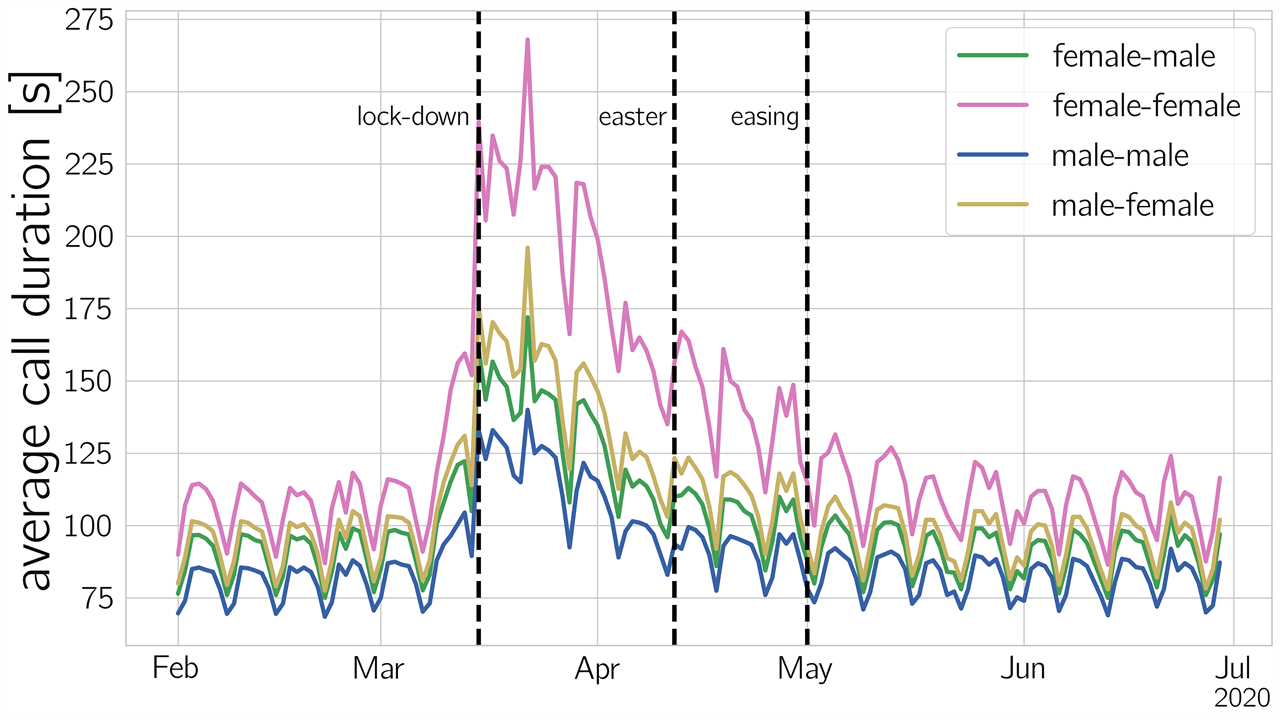First Corona Lockdown Was a “Live Experiment” – Revealed Big Behavioral Gender Differences
0 View
Share this Video
- Publish Date:
- 28 September, 2021
- Category:
- Covid
- Video License
- Standard License
- Imported From:
- Youtube
Tags

After the first lock-down was imposed in Austria on March 16, 2020, calls from women to women took up to 1.5 times longer than before the crisis (+140%), calls from men to women took almost twice as long (+ 97%). Conversely, when women called men, they talked 80 percent longer. The duration of conversations between men only increased by 66 percent. Credit: CSH Vienna
How do communication or movement patterns change in an acute crisis? Researchers in Vienna see major trends in anonymized telecommunications data and identify clear gender differences.
In a crisis, women phone significantly longer and adhere better to government measures than men; men are less likely to limit their mobility and return to normal more quickly than women. Researchers at the Complexity Science Hub Vienna (CSH) found cliché-sounding patterns of behavior like this in data from the first Corona lockdown in the spring of 2020.
For their study, just published in the journal Scientific Reports, the complexity researchers evaluated mobile phone data from 1.2 million Austrians — about 15 percent of the population — between February and June 2020.
Men and women behave very differently
“The total shutdown of public life was like a population-wide live experiment,” emphasizes CSH researcher Tobias Reisch. In the spring of 2020, the CSH gained access to anonymized telecommunications data from a major Austrian internet provider. The scientists used the data to observe people’s mobility behavior with some delay. “We were interested in the extent to which people supported the anti-Corona measures imposed by the government,” Reisch said. “When we analyzed the data by gender, we found surprisingly strong behavioral differences between men and women.” (Note: The gender categories are self-reported and are limited to women and men for technical reasons.)
Women call longer, men go out more often
People were talking on the phone for much longer immediately after the lockdown was put in place. “Interestingly, they spoke to fewer people than usual, but with these few they spoke for longer,” Reisch says.
Phone calls with women lasted significantly longer on average, with large differences depending on who called whom. After the first lockdown in Austria was put in place on March 16, calls from women to women took up to 1.5 times longer than before the crisis (+140 percent), calls from men to women took almost twice as long. Conversely, when women called men, they talked 80 percent longer, while call durations between men only increased by 66 percent.
“Of course we don’t know the content or purpose of these conversations,” says Georg Heiler, researcher at CSH and TU Wien, responsible for data processing. “Yet, social science literature provides evidence – usually from small surveys, polls or interviews – that women tend to adopt more active strategies for coping with stress, such as talking to others. Our research would confirm that.”
The researchers also found that pre-existing differences in the mobility behavior of men and women were greatly exacerbated by the lockdown, with women restricting their mobility significantly more and for longer than men.
The more detailed evaluation of telecom data obtained in a large recreation area in Vienna and a shopping center shows that both regions were visited more by men during the lockdown. Also, after the measures were lifted, men returned more quickly to their prepandemic mobility patterns.
A valuable support for social sciences
“This research demonstrates once again that data – in this case telecommunications data – enables us to gain social insights quickly and at low cost, without violating the anonymity of individuals,” added Stefan Thurner, president and co-author of CSH. “We see people’s behavior in the here and now without the need for large surveys of thousands of people.”
On the one hand, this provides quantitative support for research questions in psychology and the social sciences, including interesting new questions arising from data evaluations. “On the other hand, we provide policymakers with concrete information that can be used for planning in an acute crisis, or transition to more focused health planning, or even lead to considerations on how to achieve a more gender-equal society,” concludes Thurner.
Reference: “Behavioral differences between men and women are amplified during the COVID-19 crisis” by Tobias Reisch, Georg Heiler, Jan Hurt, Peter Klimek, Allan Hanbury, Stefan Thurner, September 28, 2021, Scientific Reports.
DOI: 2010.1038/s41598-021-97394-1










